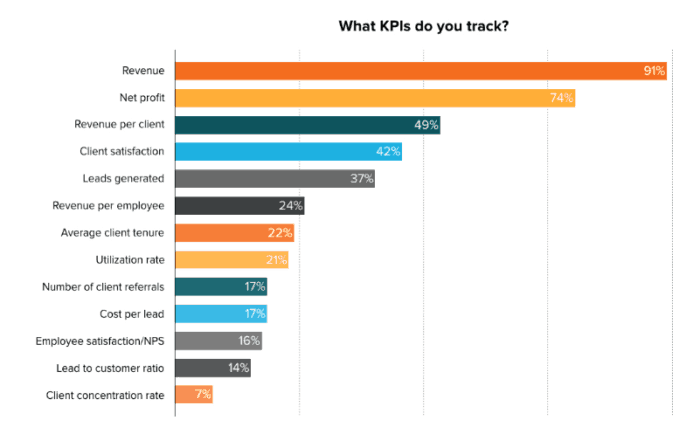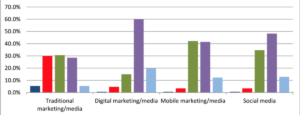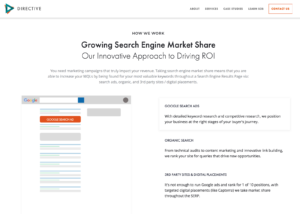Overview
As an agency that specializes in B2B marketing, we’ve seen our fair share of keyword strategies. More importantly – we’ve seen our fair share of mismanaged keyword strategies.
A strong organic strategy is not always defined by how many keywords you can rank for. At Directive Consulting, we’ve noticed that it’s often times more cost-effective to increase your market share for your most valuable keywords than it is to rank for endless new variations.
In this case study, we’ve compiled 180 Series C funded Software companies and analyzed their organic search metrics. We’ve ranked them in terms of keywords, but the spreadsheet includes two other metrics that we feel better represent the value of the keywords you target.
Click to download the eBook to learn where your company ranks (and how it holds up to your competitors).
Click here to Download the Series C Case Study for Free!
The blog post will dive into analyzing the data to see what we can learn from these sites – and how the can better nuance their keyword strategy for more value and leads.
Introduction
Search Engine Optimization (SEO) is often a long term investment in generating leads via organic results on search engine result pages (SERPs). By many, SEO is considered the more long-term, cost-effective alternative to PPC. As it can generate higher returns from less spend – when done correctly.
In the B2B marketing space, a great deal of time and resources are dedicated to long term campaigns designed on growing ROI over time. These longer-timeline projects include strategies like brand building, demand generation, public relations, content marketing, and many more. But what unites all these different strategies is the goal they share: leads.

Whether you are an SEO specialist or a PPC manager, your CEO or CMO isn’t concerned with your search performance. He wants leads for his pipeline and revenue for his business.
Especially for Series C funded software companies looking to distinguish their brand and solution across the search engine, prioritizing the right growth metrics is key. If your end goal is to generate more leads via organic, you need to reorient your metrics to adapt.
This will mean tracking metrics that report the actual value of your keywords and rankings. If you are looking for insights in the wrong places, even your optimization and growth strategies will veer off course.

To make things easier, the folks here at Directive Consulting have compiled a case study analyzing the organic search performance of Series C funded software companies.
While most search marketers are over-emphasizing the number of keywords they can rank for, too few are looking for the actual value. This is where your Organic Traffic Cost comes in. The organic calculation of keyword value via AdWords bid prices is based off the money-making potential of the keywords you are ranking for.
On top of that, we’ve created a new value metric that shows you how valuable (on average) your rankings are. With this new metric – Average Organic Keyword Value (OKV) – you can take your vague SEO efforts and refocus them into truly data-driven demand generation campaigns.
The goal here is not to say that the metrics or strategies you are currently using are wrong or useless. And it’s not to say that OKV is the new golden metric that will redefine search marketing. Instead, this case study and metric are meant to reorient your focus towards more directly growth-related tactics. These custom metrics aren’t meant to be the end-all-be-all of your new strategy. They are meant to point you in the right direction and encourage you to think of search engines as marketplaces of opportunity as opposed to just a new keyword to boost.
Tracking the Right Organic Search Metrics
So, why is it that you’ve been trying so hard to boost your rankings up to page one? Because page one takes up the vast majority of traffic for any given search entry. SEOs aim for page one of the search engine in hopes of increasing the visibility of their website and the authority of their brand.
But these are indirect representations of value. It’s difficult to pin down just how “strongly built” or “visible” your brand is. And this is where SEO has developed some bad reputations in regards to a laggy turnaround and frustratingly low ROI.

So, if SEO is supposed to be more cost-effective than PPC, why is it that so many search marketers today are so frustrated by SEO? Why is it so difficult to convince C-level executives of SEO’s value? And why is reporting success and growth one of the industry’s largest pain points?
Because many SEO specialists have been barking up the wrong tree.
The issue with tracking indirect growth metrics is that it places you at risk of running into the “blind optimization” pitfall. What is blind optimization? Well you can check out the infographic below to see.

We all want to rank as high as possible for as many keywords as we can. But aiming for the featured snippet across all your niche’s SERPs is probably not realistic. You need to prioritize where you spend your time and resources towards your most valuable keywords.
While the means may be improving your organic rankings, the ends are always the same: leads for your pipeline and revenue in your pockets. And you want that to be as short a distance as possible.
Here’s how to identify, target, and grow your market share for your most valuable organic keywords.
Tracking Value Over Random Growth
To avoid blind optimization, you’ll need to start off tracking the right metrics from the get go. There are a few organic metrics that most search marketers rely on to report organic growth or SEO wins.
- Number of Keywords
- Number of Keywords Ranking in the Top 3
- Organic Traffic Cost
- Organic Content Engagements
- Conversions from Organic Search
These are all important metrics. And each tells a slightly different story of how your organic campaigns are performing. But, the problem is that these metrics don’t show you the value of where you are placing your brand.
Search engine marketing is all about placing your brand on the most highly frequented and valuable digital placements. These can be organic results, paid advertisements, display ads, search ads, etc… But the key is to place your brand where your end customer is reading.

To do this, you need to target the right keywords. And I stress here – the right keywords. Too often these days search marketers resort to chasing low search-volume, low-competition keywords to ease their ranking efforts.
Now, long-tail keywords can be very valuable. In most cases, these search terms generate less but more qualified traffic. Long tail search entries are usually further down the funnel. For example, a search user typing “What is PPC?” into the search bar probably isn’t looking for an agency. But someone searching “PPC Agency pricing models” is most likely looking to convert/buy.
However, there are two primary drawbacks to ranking for only long-tail keyword variations.
1. The first drawback is their low search volume. While targeting long-tail keywords usually means more qualified users, it typically brings in far less of them. This can be a serious problem if you are looking to generate initial brand awareness and demand for your service.
2. This takes us to the second drawback: demand generation. Here’s a thought for you – if somebody doesn’t know what “PPC” even is, how would they know to search “PPC Agency pricing models?” This is the issue with targeting only long-tail keywords. You can’t generate enough initial demand to get the ball rolling.
The B2B Marketing Pain Point: Demand Generation
Demand generation is a huge pain point in the B2B Marketing industry. It’s an arduous process that requires multiple touches across many different social B2B marketing channels. And seeing returns can take a painful amount of time.
But why is it that demand generation is so difficult for search marketers? Well the answer is laughingly straightforward.
You can’t make your end customer search your keywords more. But, what you can do, is show up more whenever they do search your keyword.
The more market share you can take up for your most profitable keywords, the more likely you are to capitalize from the demand you generate. It’s then up to your content to take that demand and turn it into leads to fill your pipeline.
Solving Demand Generation with Demand Supply
Targeting more SERP market share is based on the understanding it’s more cost-effective to supply the demand than generate it from scratch.
There are two reasons for this. For starters, the primary keywords you’d have to rank for to generate necessary demand are often very competitive. Especially in a saturated market like search engines, an SEO can drown in the competition of high volume keywords.
The second reason is theoretical, but quite serious. The truth is that even if you manage to build the top of your funnel from scratch and generate all of that demand, there is nothing stopping a competitor from hopping on that traffic wave and taking all the leads from you.

If you take nothing away from this blog post, at least remember this:
Ranking for keyword isn’t guaranteed to get you more leads or revenue.
It’s much more feasible to build on top of demand that already exists in the search engines. By diversifying how you target your most profitable SERPs you can take up the market share for already high demand, high volume markets. These are the placements you need to be doubling and tripling down on.
So how do you focus your efforts and resources towards the right keywords? How do you know you are headed in the right direction? SEOs deal in an array of vague tactics like link brand building and digital PR that making tracking a nightmare. We need a metric that can point us in a focused direction.
And that’s where OKV comes in.
The Money Metric: Average Organic Keyword Value (OKV)
This new metric reports on the value of the keywords you are targeting in your organic campaign. The calculation is quite simple. But first we have to look at two other metrics under the microscope.
Number of Keywords: The number of unique keywords bringing users to your site via Google’s top 100 organic search results – essentially how many different keywords you are ranking for organically, whether you are ranking on page 1 or page 10.
Organic Traffic Cost: Estimated price of organic keywords in Google AdWords – essentially shows you how much you would be paying in AdWords to show ads for the same keywords you are currently ranking for organically. Ideally, you are generating this same traffic for free via your organic rankings.
Increasing the number of keywords you rank for doesn’t necessarily mean you are going to see an increase in traffic cost. Especially if you’ve been bitten by the over-optimization bug and are ranking for only long-tail keywords, you probably aren’t seeing any actual returns or lead gen from your SEO efforts. And probably for one of two reasons:
The first: lower search volume for long tail keywords. While these search terms usually generate more qualified traffic, the SERPs that they generate are seen by far less users. This means that, even if they are qualified, you are generating only a small percentage of your potential leads. Which can make hitting growth goals difficult.
The second: demand generation. To generate leads for your business you have to leverage the existing demand in the market or create the demand for your service/solution through education and brand exposure. Targeting long tail keyword variations is only half of the equation. You have to make sure that the customer knows to search your long-tail keywords at the outset. The primary, top-of-funnel demand and brand awareness still has to be developed.
The biggest issue sabotaging your ROI is most likely your SEO strategy itself.
More often than not, search marketers get caught up in vague metrics from the get-go, from keyword targeting to optimization goals. While boosting vanity metrics like Number of Keywords maybe an impressive SEO feat, it’s not going to directly raise your bottom line. Instead, start looking at the value of the keywords/SERPs you are targeting as opposed to the rankings of those SERPs.
Average OKV shows you this value in dollar amount. By dividing your Organic Traffic Cost by your Number of Keywords you get an average dollar amount – a single number ratio you want as high as possible.

Now, let’s take a look at OKV in action and see what insights it provides.
OKV eBook: Breakdown of Series C Software Industry
The spreadsheet below includes all the data that the following sections analyze. The spreadsheet’s subject group is the top 180 Series C funded Software companies (as well as Directive Consulting, for transparency’s sake).
For each site we’ve compiled the Number of Keywords, Organic Traffic Cost, and calculated the Average OKV.
Click here to download the spreadsheet for free!
Now that you’ve found your site in the rankings – let’s take a look at what we can learn from the different range of results.
Analytical Breakdown of Series C Software OKV
To make things easier, we’ve broken down the analysis into sections determined by the number of keywords. This way you can compare and contrast your keyword strategy to companies who are employing a similar number of keywords, but may have a different OKV. These insights should show you how you can improve your own keyword strategy and organic campaigns to beat out those of your competitors.
For the most part, there are four primary categories that the results fall under. First, there are those with a massive amount of keywords and a high Organic Traffic Cost (let’s call these “big winners”). Then, there are those with a significant amount of keywords but a more reasonable Organic Traffic Cost (one that doesn’t spike into the millions – let’s call these “the solid sites”).
Then there are those sites that have one of their number skewed, either a radically high number of keywords or Organic Traffic Cost. I’ll call these sites “Up & Comers” because skewed metrics like these often mean one of two things. Either 1: the company has recently identified it’s highest SERP markets and has yet to rank high for them, or 2: the company has an abnormally high Organic Traffic Cost by only targeting high volume, primary keywords – which means that is must be doing something right.
Lastly, the fourth category will cover sites that have no apparent keyword strategy and are targeting only a small number of keywords (less than 1000) and often have a negative OKV ratio. These sites need guidance in the most urgent sense. But, in terms of actual insights into how to improve their campaigns, there’s only one real take away for them: build an actual strategy and start treating search marketing seriously!

For more actionable insights into how you can improve your keyword strategy to target more valuable opportunities, fill out the form below. By providing us with your company and two main competitors, we’ll analyze your Organic Traffic Cost and Average OKV for you and respond to your email with an in-depth analysis.
Case Study Takeaways: Understanding OKV
So, having combed through the different range of results, we’ve seen that there are many different ways to leverage your brand across different keyword opportunities.
In search marketing, the rules are not very different from real-estate. Rules one through three are still “Location,” “Location,” “Location.” However, the rule does not stress how many locations, but the value of a singular one.
If you can start applying the same logic to the SERPs, you are more likely to see an ROI that pleases your bosses upstairs. So, how can you present this new metric and improve it to show your executives a keyword strategy with a climbing OKV and continually increasing ROI? By taking up search market share on your most valuable SERPs.
Improving Average OKV with Increased Market Share
Search Engine Market Share is a new model of search marketing developed here at Directive Consulting.

We noticed that many search marketers are stressed to hit growth metrics by improving their own vanity metrics. An SEO will work to improve on-page SEO and rank new pieces of content, but that is a direct form of lead generation at best. Many times even multi-channel digital agencies that employ SEO, PPC and Content Marketing are caught up by the wrong focus.
By reorienting your growth team to focus only on leads and deals won/closed, you can reallocate resources to do the same. This is where OKV and high-value, data-driven demand generation come from. Each is part of a larger picture – taking up more search engine market share to improve SEM’s ROI and lead gen power.
Conclusion: Value Metrics > Vanity Metrics
Whether you were at the top of the rankings or the bottom, the conclusion is the same. As a whole, search marketers need to be wary of the keywords they are targeting beyond their SEM purposes. This means developing strategies that grow value, leads, and revenue instead of just organic search metrics.
There are two voices battling in the minds of search marketers. The first is the specialist; the SEO or PPC technician who wants to optimize every page and post for Google’s crawlers. The other is the marketer, the businessman; the one who has to make money for the company.
Too often these two voices are at odds with one another, or simply one wins out and the other is silenced. It’s high time they start to work hand-in-hand in a focused, comprehensive search marketing campaign.
Download your free spreadsheet to see the full case study/analysis.
-
 CEO
Garrett Mehrguth
CEO
Garrett Mehrguth
Did you enjoy this article?
Share it with someone!


